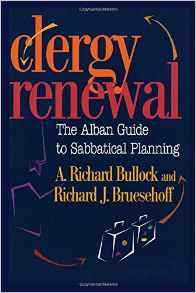|
|
Clergy Renewal The Alban Guide to Sabbatical Planning A. Richard Bullock and Richard J. Bruesehoff The Alban Institute, 2000, 89 pp. ISBN 1-56699-223-0 |
|
|
BulCler 03-2-12 |
||
|
|
||
“I have come to think that the recovery of the Sabbath is the most crucial and most demanding covenant command (spiritual discipline) now to be faced in the technological society.” Walter Brueggemann, from the back cover.
Clergy Renewal is a practical book to prepare both the
pastor and the congregation for an effective sabbatical.
“The very nature of being an effective pastor involves
continual spiritual growth. Spiritual
depth does not happen by accident; it takes hard, intentional work. Basically, it is a lifelong process….” “Trying to do this while working between
forty-five and fifty-five hours each week is nearly impossible.” (Foreword, Roy Oswald)
A sabbatical is a time for rest, renewal, and new hope. It provides energizing renewal. It should nourish the soul and rebuild the
body. It should help us to step off the
treadmill long enough to change old habits.
It is a time to relearn and rehearse that critical capacity to
reflect. It is a time to lie fallow, a
time to receive rather than give, to get input rather than give output, to
carefully nurture and cultivate our lives.
A sabbatical is about a pilgrimage with Jesus toward God. (4-9)
“A sabbatical policy should define who is eligible to
receive renewal leave, when a sabbatical leave may be taken, the length of
leave allowed, the salary and benefits that will be paid during the leave, how
much can accrue to cover educational costs, and how the congregation will cover
the cost of staff replacement. The
policy should also outline a sabbatical planning process and be explicit about
commitments following the sabbatical.”
(12)
Take the sabbatical when you can take vacation time before
and afterwards so you can shift gears, unwind beforehand, and take several days
for reentry. (14)
Questions to ask for focusing the sabbatical: (16)
- What
will I read?
- Where
will I study?
- Where
will I travel?
- Where
will I spend time in retreat?
- How
much time will I spend reading or taking classes?
- How
much time at home?
- How
much at a retreat center?
- How
much time volunteering with a service organization?
- How
much time in action?
- How
much time in reflection?
Maintaining flexibility and a sense of expectancy seems to
be the key. Don’t use the sabbatical to
do more of what you already do! (18)
Some divide the time into blocks, e.g.: (19)
- Resting,
renewal, and rebirth.
- Letting
go, living in God’s presence, and reorientation.
- Decompression,
transition, reentry. Etc.
Sabbatical renewal leave typically includes time for rest,
travel, prayer, study, renewing relationships, worship, and living in different
cultures. (19)
At the beginning of planning let yourself dream. Write on a piece of paper: Sabbatical
Dream? When? Where? With whom? How long?
Cost and funding? (19)
Travel is one of the keys.
It disconnects us from home and gives us new perspectives. What is the trip, journey, or pilgrimage
that you have always wanted to take?
(22-23)
The heart of the sabbatical is time and space for
renewal. (26)
A consultant who helps you plan might ask:
- In
what areas of your life do you desire renewal?
- What
will bring you joy during the renewal leave?
- How
would you spread your wings or deepen your roots?
- Where
is God moving in your life?
- What
challenges and opportunities are facing your congregation?
- What
would you like to learn or experience?
(27)
The following questions might be helpful for review
afterwards:
- What
went well?
- What
did you learn and how will you use it?
- What
surprised you?
- What
would you do differently?
- What
persons, programs, locations, funding or comments were most helpful?
- What
is your favorite sabbatical story?
(53)
Plan for you reentry.
Don’t immediately jump back into the job. Go light on scheduling during the first week back. Prepare for a range of emotions. Expect the deepest and most significant
learning to become evident over time.
(54)
“Be intentional, but allow yourself enough freedom to change
directions of let go of an old dream if a new vision emerges.” (62)
Set out with enthusiasm and expectation. (65)
Appendix B. Sample
Sabbatical Policies
A bibliography of sabbatical literature is included.
